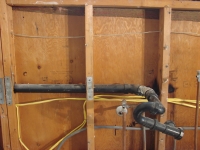» Residential Home Wiring Diagrams
» Need Electrical Help? Ask the Electrician
Wiring Projects

|
By Dave Rongey
Summary: Here is a Great Electrical Wiring Question - Frank from Illinois asks: How many romex 12-2 and how many 14-3 wires am I able to run through an interior wall separating two rooms?In this article on Home Wiring Remodel Tips we will take a look at how to safely install romex house wire and methods to protect the wire from damage. © By: Dave Rongey |
The Protection of Electrical Wiring is Extremely Important
Safe Wiring Practices
Always use the correct size wire for your circuit. If adding onto an existing circuit make sure to match the existing wire size and type.
Install wiring so that it is protected and will not be damaged by dry wall or wall covering fasteners such as screws or nails.
Drill holes in the center of the framing stud. Before drilling holes look on the opposite side of the framing stud to be sure it is clear of other wiring, pipes or any other existing such system device components.
Always use Metal Safety Plates to protect the electrical wiring where it could be damaged from wall covering nails or screws.
Great Electrical Wiring Question - Here is the Answer!
There is no limit as to how many Romex wires you can run between two rooms, the home wiring method would be the factor when wiring remodel construction projects.
The path for the Romex wiring must be installed using methods which will protect the wiring from nails and screws used to install sheet rock and other wall coverings.
Drill the holes for the Romex in the center of the wall studs or framing material used for your remodel construction. If the holes get too close the outside of the studs, then be sure to protect the home wiring or Romex by using Safety Plates, also know as Nail Plates.
Below you will see some home wiring photos of recent remodel construction projects that I have selected to help you with your project.
[Click on the images to Enlarge]
|
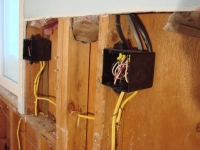 |
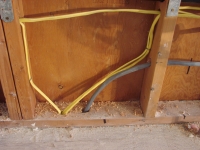 |
|---|---|---|
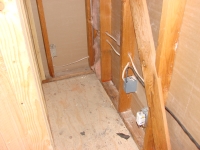 |
In areas where the home wiring may be vulnerable to harm of sheet rock screws or nails, always install Safety Nail Plates to protect the wiring!
When remodeling, routing wiring through corners is a special area of concern because the sheet rock will be anchored securely in this area.
The electrical wiring should be back 1-1/2' away from both nailing surfaces - Interior and Exterior.
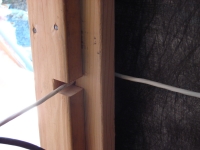 |
 |
|
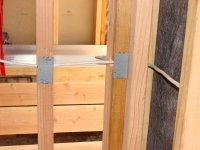 |
 |
|
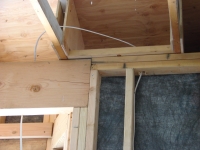 |
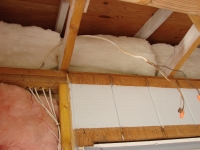 |
The Safest Way to Test Electrical Devices and Identify Electric Wires!The Non-Contact Electrical TesterThis is a testing tool that I have had in my personal electrical tool pouch for years, and is the first test tool I grab to help identify electrical wiring. It is a Non-contact tester that I use to easily Detect Voltage in Cables, Cords, Circuit Breakers, Lighting Fixtures, Switches, Outlets and Wires. Simply insert the end of the tester into an outlet, lamp socket, or hold the end of the tester against the wire you wish to test. Very handy and easy to use.
The Quickest Way to Check for Faulty Electrical Wiring!The Plug-In Outlet TesterThis is the first tool I grab to troubleshoot a problem with outlet circuit wiring. This popular tester is also used by most inspectors to test for power and check the polarity of circuit wiring. It detects probable improper wiring conditions in standard 110-125 VAC outlets Provides 6 probable wiring conditions that are quick and easy to read for ultimate efficiency Lights indicate if wiring is correct and indicator light chart is included Tests standard 3-wire outlets UL Listed Light indicates if wiring is incorrect Very handy and easy to use.
Strip Off Wire Insulation without Nicking and Damaging the Electric Wire!The Wire Stripper and Wire CutterMy absolute favorite wire stripping tool that I have had in my personal electrical tool pouch for years, and this is the tool I use to safely strip electrical wires. This handy tool has multiple uses: The wire gauges are shown on the side of the tool so you know which slot to use for stripping insulation. The end of the tool can be used to grip and bend wire which is handy for attaching wire onto the screw terminals of switches and outlets.. The wire stripper will work on both solid and stranded wire. This tool is Very Handy and Easy to Use. |
||
Residential Electrical Parts and AccessoriesLight Switches 120volt Outlets Circuit Breakers Electrician Tools Voltage Testers |










